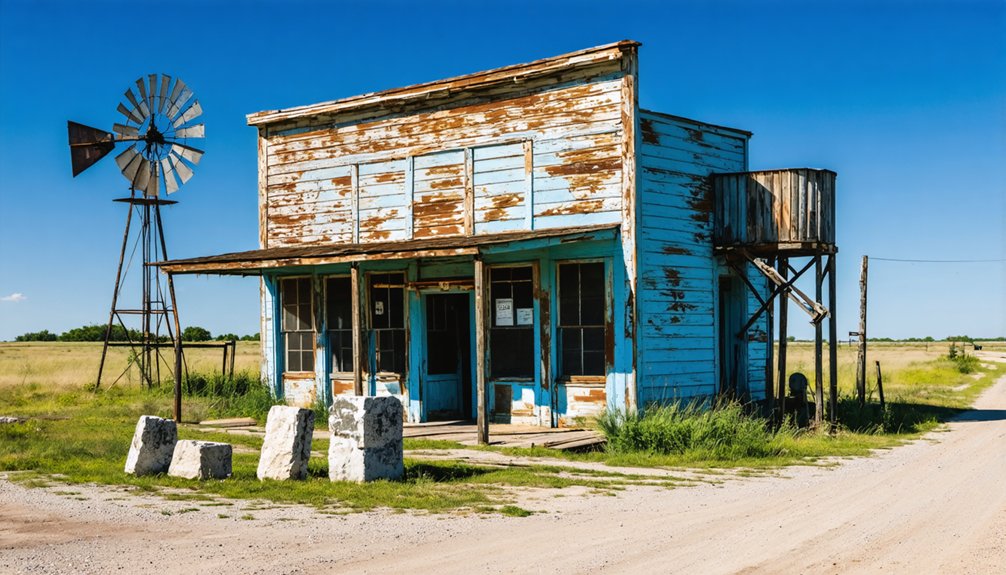You’ll find Bryant Station, a fascinating Texas ghost town, along the Little River in Milam County. Established in 1840 by Benjamin Franklin Bryant as a fortified trading post, it served as both a military outpost and diplomatic hub. While it thrived as a frontier settlement managing indigenous relations, the arrival of the Houston & Texas Central Railway in the 1860s led to its decline. The remnants, including a historic cemetery and camelback bridge, tell a deeper story of Texas’s frontier transformation.
Key Takeaways
- Bryant Station was established in 1840 as a fortified trading post along Little River in Milam County, Texas.
- Founded by Benjamin Franklin Bryant, it served as both a military outpost and diplomatic hub for Native American relations.
- The settlement declined after the Houston & Texas Central Railway bypassed it, shifting economic activity to railroad-connected towns.
- The ghost town’s remains include a historic cemetery, old camelback bridge, and modern bridge spanning Little River.
- Local historical societies work to preserve Bryant Station’s legacy through cemetery maintenance and documentation of artifacts.
Early Origins and Strategic Establishment
As Texas expanded its frontier in the 1840s, Bryant Station emerged as a critical fortified trading post along the Little River in what would become Milam County.
Benjamin Franklin Bryant, a Battle of San Jacinto veteran and friend of Sam Houston, established this strategic outpost in 1840 to serve both defensive and diplomatic purposes.
You’ll find that frontier diplomacy shaped the station’s early role, as Bryant received his appointment from the Republic of Texas specifically to manage indigenous interactions.
The settlement combined a homestead with fortified structures, reflecting the delicate balance between civilian life and military necessity.
The station’s placement wasn’t random – it served as a calculated buffer zone between hostile Native American tribes and eastern settlements, while facilitating trade and securing essential territory for Texas’s continued expansion.
Though the station thrived initially as a commercial center, the establishment of the railroad at Buckholts ultimately led to its decline.
The old camelback bridge, cemetery, and modern bridge are all that remain of this once-thriving community.
The Rise of a Frontier Fort Community
While Benjamin Franklin Bryant’s initial fort provided the nucleus, Bryant Station rapidly evolved into a thriving frontier community shaped by its strategic location on the Little River and the Austin to Marlin stage line.
The settlement dynamics centered around the fort’s protective walls, where you’d find Bryant’s extended family and other pioneers seeking refuge from Native American raids. Similar to the bravery shown at Bryan Station in Kentucky, women played crucial roles in gathering resources and maintaining the settlement. After leading militias against native tribes, Bryant built a new home in 1845 near the fort to accommodate his growing family’s needs.
As the community grew, it established itself as a vital hub for:
- Collective defense through militia systems and fort watch rotations
- Economic activities including farming, livestock trading, and stage line services
- Social gatherings that strengthened bonds between settlers
The community defense strategy proved effective, as Bryant’s military experience and leadership helped create a secure environment where trade flourished and settlers could establish permanent homesteads despite frontier challenges.
Military and Trading Post Operations
Under Major Benjamin F. Bryant‘s command, Bryant Station emerged as a critical frontier outpost that masterfully balanced military strategy with trading dynamics.
You’ll find that the station’s dual purpose served both defensive and economic interests, as Bryant’s appointment as Indian Agent by Sam Houston in 1842 formalized this unique arrangement.
The station’s location near Little River’s crossing made it perfect for monitoring Native American movements while facilitating commerce between settlers and tribes. The fort spanned across three thousand acres and became a vital regional stronghold.
You’d have seen U.S. Army troops maintaining security alongside traders conducting business, with a post office established in 1848 supporting these operations. Major Bryant’s experience from the Battle of San Jacinto proved invaluable in managing the station’s military affairs.
The site became essential for Texas Rangers’ operations against Indian raids, while simultaneously serving as a diplomatic hub where structured trading relationships helped maintain relative peace in this contested frontier region.
The Impact of Railroad Development
As the Houston & Texas Central Railway expanded northward in 1859-1860, you’d see Bryant Station’s economic influence gradually diminish while new rail-connected towns like Bryan gained prominence.
First train service began in Bryan on August 19, 1867, marking a definitive shift in regional transportation patterns. The railroad’s strategic routing decisions shifted commercial activity away from Bryant Station’s earlier trading hub status by creating more efficient transportation corridors through neighboring communities.
The town of Bryan, named after William J. Bryan, became a significant settlement after donating land for the railroad’s townsite. You’ll find that by the 1870s, the completion of rail connections to Denison had solidified this economic realignment, effectively marginalizing Bryant Station’s role in regional commerce.
Railroad Economic Shift
When the Houston & Texas Central Railway reached Bryan in 1867, it triggered a dramatic economic transformation that would ultimately seal Bryant Station’s fate.
You’ll find this railroad impact reshaped the entire region’s economic landscape, as towns with rail access flourished while others withered. The arrival of the railroad brought telegraph service and the first general store to Bryan, establishing vital communication networks.
The shift in economic power became evident through:
- Mass relocation of residents from Bryant Station to railroad-connected towns like Bryan
- Establishment of crucial commercial infrastructure including telegraph offices and general stores along rail lines
- Integration of local agricultural markets into broader trade networks, reducing transportation costs
Bryan’s rise as Brazos County’s urban center, supported by multiple railroads including Missouri Pacific and Southern Pacific, stands in stark contrast to Bryant Station’s decline, demonstrating how rail access determined a town’s economic destiny.
Transportation Route Competition
The fierce competition between railroad companies near Bryant Station shaped the region’s development throughout the late 1800s.
You’ll find that the Houston & Texas Central Railway and International & Great Northern Railroad engaged in intense route optimization, establishing parallel lines just five miles apart near Bryan. This strategic positioning created a battleground for freight competition and passenger services.
When you look at the collaboration between H&TC and Katy railroads, you’ll see how they coordinated service between Houston and St. Louis, while still competing for local traffic.
The Gulf, Colorado and Santa Fe Railway’s construction in 1881 bypassed Bryant Station by three miles, accelerating its decline. The railroads’ influence determined which settlements would thrive – Bryan flourished while Bryant Station declined.
After Southern Pacific absorbed H&TC in the early 1880s, the competitive landscape shifted again, reshaping transportation patterns across Central Texas.
Legacy in Texas Ghost Town History

Founded by San Jacinto veteran Benjamin F. Bryant in the 1840s, Bryant Station stands as one of Texas’s most compelling ghost town narratives.
You’ll find this former fortified trading post‘s cultural significance deeply woven into the fabric of Milam County’s heritage, representing the complex relationship between frontier settlements and Native American territories.
The town’s legacy lives on through:
- Its role as a strategic buffer settlement that helped shape Texas’s frontier defense strategy
- The cemetery and old bridge that serve as tangible reminders of early Texas settlement patterns
- Its documentation in historical records as a prime example of how railroad routing determined a community’s fate
Today, you can trace Bryant Station’s transformation from a thriving frontier post to a ghost town, reflecting broader patterns of settlement and decline in Texas history.
Preserving Bryant Station’s Heritage
You’ll find the Bryant Station cemetery serves as the primary physical link to this once-thriving frontier settlement, making its preservation essential for future generations.
Local historical societies work to document and protect remaining artifacts, infrastructure, and archaeological sites that tell the story of pioneer life in 19th century Texas.
The Milam County Historical Commission actively promotes research and awareness through educational programs, while preservation groups focus on maintaining the cemetery and collecting oral histories from descendants of original settlers.
Historical Site Conservation
Despite its historical significance, preservation efforts at Bryant Station face considerable challenges, focusing primarily on maintaining the cemetery as the last visible remnant of this once-thriving community.
Community engagement and funding challenges continue to impact conservation work, while natural erosion and vandalism threaten the few remaining physical traces.
Key preservation initiatives include:
- Documentation by the Texas State Historical Association and local historical commissions
- Placement of historical markers to inform visitors about the site’s origins
- Partnerships between public institutions and private societies to share resources
You’ll find that access to the site is limited, with the old bridge over Little River closed to traffic.
While the cemetery remains the primary focus of preservation work, digital archives and historical registers help maintain Bryant Station’s legacy for future generations.
Documenting Local Pioneer Life
Through meticulous documentation of pioneer life at Bryant Station, historians have preserved a rich tapestry of early Texas frontier experiences.
You’ll find records detailing Benjamin Bryant’s vital role as Indian Agent and his leadership during the Battle of San Jacinto, highlighting the settlement’s strategic importance in Texas history.
The documentation reveals pioneer hardships faced by the settlement’s inhabitants, from defending against Indian raids to maintaining self-sufficiency through farming and trade.
You can trace the community’s resilience in historical markers, local writings, and preserved oral histories that capture daily life at the fortified settlement.
The station’s transformation from a bustling hub with a post office and stage stop to a ghost town represents the changing frontier landscape.
These preserved accounts provide invaluable insights into the authentic Texas pioneer experience.
Frequently Asked Questions
Are There Any Remaining Structures or Ruins Visible at Bryant Station Today?
While you’ll find the historic 1909 bridge still spanning Little River and some cemeteries, there aren’t any remaining structures or visible ruins from the town’s buildings at Bryant Station today.
What Happened to Benjamin F. Bryant’s Descendants After the Town’s Decline?
You’ll find that Bryant’s descendants’ stories reflect migration within Texas, settling in Milam, Bell, and Williamson counties. They preserved family legacies while shifting from farming to urban life by the 1900s.
Did Any Notable Gunfights or Indian Battles Occur at Bryant Station?
Like a whisper in the wind, Bryant Station’s gunfights history is surprisingly quiet. You won’t find major shootouts there – just scattered Indian skirmishes, including a failed 1839 battle nearby that cost 18 lives.
What Was the Peak Population of Bryant Station During Its Height?
You won’t find a documented peak population for this settlement. Historical records don’t provide exact numbers, though population trends suggest it likely never exceeded a few hundred residents during its brief historical significance.
Can Visitors Legally Explore the Bryant Station Site in Modern Times?
You’ll need permission to explore most areas since they’re on private land, though you can legally access historical markers and the cemetery. Respect posted signs and property boundaries.
References
- https://www.ghosttowns.com/states/tx/bryantstation.html
- https://discovertexasoutdoors.com/places/bryant-station/
- http://www.milamcountyhistoricalcommission.org/newspaper_114.php
- https://texashistory.unt.edu/ark:/67531/metapth87439/
- https://www.tshaonline.org/handbook/entries/bryant-station-tx
- https://www.texasescapes.com/CentralTexasTownsSouth/Bryant-Station-Texas.htm
- https://www.raynerachels.com/2023/04/the-real-bryant-station-backdrop-for.html
- https://www.twtex.com/forums/threads/texas-ghost-towns-proposal.33379/
- https://en.wikipedia.org/wiki/Benjamin_Franklin_Bryant
- https://en.wikipedia.org/wiki/Bryan_Station



